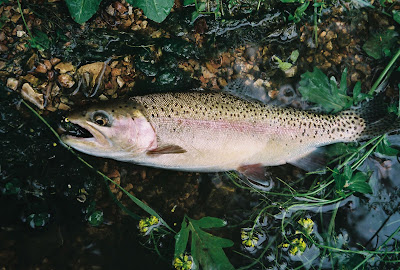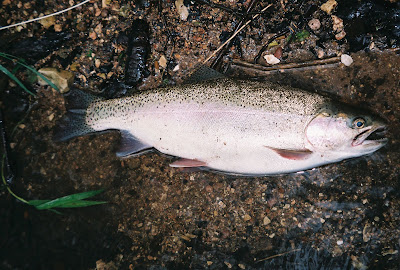Utah is not always the first state that comes to mind for people that spend time fly fishing for trout. The Green and Provo rivers are well-known fisheries to the north, but much of the rest of the state receives little attention, at least from anglers outside of the region. This is especially true of southern Utah, which is more often associated with deserts and spectacular national parks, such as the towering sandstone cliff walls of Zion.

Even in the desert, springs and other pockets of water provide havens for wildflowers and other life, such as this vivid columbine, found not far from the image above.

The multicolored hoodoos and stone sculptures of Bryce Canyon are also deservedly well-known and evocative.

Regan and I traveled through this part of the country and explored some of these awe-inspiring landscapes. I would highly recommend taking some time out to appreciate these natural wonders, even to those in search of trout.
In fact, southern Utah contains a number of fine wild trout streams, and some of these even possess native cutthroat adapted to demanding desert conditions. One such destination is the East Fork of the Sevier River, which holds populations of Browns, Rainbows, and Bonneville cutthroat.

Here is a picture of a stretch through Kingston canyon, marked by scenic cliffs and surrounding ranchland. This part of the river is known to hold some large Brown trout, although the best fish I found on this visit was a Bonneville cutt, a trout native to Utah (and the state fish), as shown below.

Note the reddish purple ventral fins on this specimen--one of the identifying features of this subspecies. Somehow, even with competition from introduced Brown and Rainbow trout (and potential hybridization with the latter), some of these cutthroat persist, and by all appearances seem to still remain relatively pure-strain.
The best fishing on the East Fork occurred upstream, in a section called the Black Canyon. A state highway parallels this stretch, but it is still rugged, and characterized by frequent boulders, plunge pools, and at times treacherous wading and rock-hopping conditions. The water was running a bit high and off-color, and this seemed to invigorate the trout. I managed to catch numerous beautiful Browns, a few Bonneville cutthroat, and several cuttbows, primarily on #10 BH brown Girdle bugs, as stonefly nymphs were abundant in the healthy currents--prime spring fly fishing.

My wife Regan does not often fly fish (although she has the potential to be a very good angler), but she was determined to fish here, picked up the nymphing techniques quickly, and succeeded in hooking a number of trout, including this 12-13" Brown.

It was as much of a joy to watch her high stick the currents and find some willing fish as it was to fish myself. I consider myself fortunate indeed to have a partner that shares my love of the outdoors, accepts my passion (obsession) for fly fishing, and at times enjoys participating in the activity herself.
Here are some more photos from the East Fork of the Sevier, as the pictures can probably do more justice to describing the fine fishing than my words can. A scrappy 14" Brown is shown below, one of the first really good fish I caught here (anything over a foot seemed to be a nice one).

And here is a colorful, large male Bonneville cutthroat that I caught, a good 15", the best native and one of my favorites caught on this outing.

A close-up of the cutt's head is shown below, and the namesake bright orange throat slashes are evident.

The East Fork was filled with pocketwater through the Black Canyon, and each lie seemed to hold a hungry trout in the turbid water--fast and fun fishing.

A few more trout are pictured below, including a head shot of a 13" Brown.

One of the largest fish caught here was this 16" Brown, from a waist deep pool.

The Bonneville cutthroat were not overly abundant, but always a welcome surprise when caught. Another classic-looking specimen is pictured below, a good foot-long fish.

Yet another strong wild Brown, this one just under 16", poses with an open jaw and sharp teeth.

Here is a representative shot of canyon water, with plunge pools and pockets everywhere, one of my favorite types of water to cast a fly.

And finally, I included one last picture of Regan, holding a fine foot-long Brown, hooked through overhanging brush and considerable woody debris in a small pool (not an easy trout to fool, like most Browns). She played the fish quite expertly, managed to weave it through snag-filled structure, and then brought the fish to hand--success!

Plentiful and willing wild trout, good scenery, and sharing time along the stream with Regan--I couldn't have asked for much more from a great couple days of fly fishing.
A number of intriguing and under-visited trout streams exist in southern Utah, and I would recommend the area to any angler seeking solitude, wild fish, and landscapes stretching across ranchland and open scenic country.

















